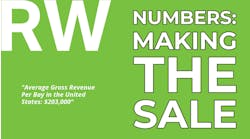On the top of every shop owner’s mind is hiring. Are there enough qualified technicians, service advisors and shop managers? And how do I get them to come to my shop?
Shop owners increasingly need to find ways to get the best candidates interested in their shop. Vacation and sick days are becoming a basic necessity. Roughly 88 percent of shops offering vacation and nearly two-thirds provide sick days, according to the 2020 Ratchet+Wrench Industry Survey.
So to stand out, shops may need to go beyond that. Having a good work environment and committed workforce is a start, but there are increasingly popular ways to get more money into the pockets of your employees.
Ratchet+Wrench spoke with a pair of shop owners who have different philosophies on profit-sharing incentives to understand why they offer what they do.
What is profit-sharing?
Profit-sharing is an incentivized compensation program that awards employees a percentage of the company's profits. The amount awarded is based on the company's earnings over a set period of time, usually once a year. Unlike employee bonuses, profit sharing is only applied when the company sees a profit.
Tiers to succeed
Ramy Nazim’s background is in the software industry. That’s where he saw the basic outline of the profit-sharing system that he’s now implemented as marketing director for the Texas-based Integrity 1st Automotive.
He looked around the organization, which had a traditional linear bonus structure across its six shops and sought to create something more dynamic. The idea was to create a meritocracy of sorts.
“I wanted to allow shop managers to reap the benefits of their merit,” he says.
What he came up with was a tiered system that would award shop managers exponentially as profits increased. Nazim was reluctant to share the specific details of his plan for competitive reasons, but outlined an example of the structure.
First the company identifies the average monthly break-even point for the store. Once the shop goes above that and has a cash flow positive month, the benefits start to kick in. Nazim suggests tiers based on consistent increments that are reasonable for the specific business. In his example, that was $10,000. In that first tier the shop manager gets 5 percent of the profits. For every $10,000 increment that the shop passed after that increases the managers percentage by 3 percent.
Nazim says it's rare for a shop manager not to receive any profits. It has also helped in recruiting. In Integrity’s latest round of hiring, the system peaked the interest of many.
The benefits have gone beyond just putting more money in the shop managers’ pockets. Nazim says the program was designed to give shop managers more accountability, autonomy and ownership over the business. With just a guaranteed salary or hourly wage, the incentive to grow and maximize profits isn’t there. With this system, it is.
The shop managers are more engaged in understanding the business’ financials, where the break-even point is and how to maximize the company’s profits and losses.
However, Nazim warns that maintaining the integrity of the company is vital. If managers get their sights solely set on maximizing profits, it risks customer service and competitive pricing. Nazim says the company is very transparent in telling the shop managers that it has to maintain competitive pricing. They frequently audit invoices to make sure that is being followed.
Before a shop implements the program, Nazim recommends having a strong understanding of the financials. The foundation of the program rests on knowing the breakeven points, which may fluctuate during different times of the year. Shops need to establish that before a system is in place.
Long-term approach
Greg Skolnik, an industry coach and owner of Motor Works auto repair in Rockville, Md., has a different take on profit-sharing, one that’s much more focused on the long-term than on short term benefits.
He believes the future of incentivizing is in retirement plans. In fact, he’s had a retirement plan established at his business for more than 20 years.
But according to the 2020 Ratchet+Wrench Industry Survey, only 44 percent of repair shops offer a retirement plan or 401(k).
“It’s not common enough,” Skolnik says.
Skolnik said he has floated the idea of a system like Nazim’s in the past, but his workers preferred a retirement plan, which benefits all employees and doesn’t pit anyone against each other for sales. It also benefits the business owners, who can put profits from the company into their own retirement and also receive tax breaks.
Skolnik’s 401(k) program mirrors many of the plans that are becoming standard in society today. After accruing a year of work for the company, a 401(k) is opened for workers. Skolnik contributes three percent of the employees salary to the fund whether the employee contributes individually or not. That way, even employees who believe “savings is for the birds,” are receiving money towards retirement.
For many technicians, especially younger ones, thinking about retirement often isn’t a priority. That doesn’t mean businesses should follow suit. Educating and encouraging employees to begin saving is important, Skolnik says. He remembers receiving some pushback after initially putting the plan in place. His response?
“Trust me.”
Skonlik asked his employees to just watch it happen. After a year the employees saw the savings and came to the realization that they barely knew the money was coming out of the paycheck. Since then, if Skolnik gets any pushback, he relates it to a car payment. Just get in the habit of paying it every month and understanding it’s of benefit to you.
Then at the end of the year, if the company turned a profit, Skolnik will reinvest the remaining money back into the retirement fund. Some years that has amounted to roughly 10 percent of the employees yearly salary that is reinvested into their individual plan. The only year Skolnik did not reinvest profits was following the 2008 economic crisis.
Implementing a retirement plan comes with a necessity to educate. Both shop owners and entry-level employees often struggle to see the benefits of a retirement plan as there are immediate earnings that are being sacrificed for long-term financial success.
In that way, retirement plans don’t seem like the obvious definition of a profit-sharing incentive. Skolnik brings in an accountant yearly to talk through the plans and educate the staff about the benefits.
Skolnik expects retirement plans will continue to become more popular as the industry tries to attract talent.
“If you don’t have (retirement) benefits in place, you’re going to be left out in the cold,” he says.
The bottom line
Nazim’s profit-sharing system and Skolnik’s retirement plan are just two of many ways to get more money to your employees and further incentivize talent to choose a shop. Not every plan may make sense for every business. Understand the shop’s finances and what it has the room to do. Nazim recognizes his plan might not make sense for franchises. In his mind, MSO’s would receive the greatest benefit. But whether it’s one of these plans, or a simple bonus structure, shops need to do something.
“You want to have a way to provide obviously a guaranteed salary that your employees can reach but also you want to create additional incentives, whether it’s a bonus, commission or whatever,” Nazim says.
SHOP STATS: Integrity 1st Automotive Location: Six locations in Dallas-Fort Worth Metroplex Owner(s): Kevin Syed Average Monthly Car Count: 230-380 Staff Size: 5+ Shop Size: 4,000-6500 sq. ft. Number of Lifts/Bays: 10+ ARO: $300-450 Annual Revenue: $630,000 - 1.2 million
SHOP STATS: Motor Works, Inc. Location: Rockville, Md. Owner(s): Greg Skolnik Average Monthly Car Count: 170 Staff Size: 7 Shop Size: 3,000 sq. ft. Number of Lifts/Bays: 7 ARO: $615 Annual Revenue: $1.25 million



